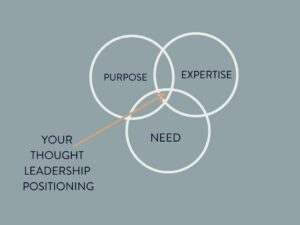Nail your unique positioning: how to take a PEN to thought leadership
Getting cut through as a thought leader often comes down to how well you can articulate your own unique position. That’s the thing that your audience can turn to you for amongst the hustle and bustle; the area in which you can move their thinking forward and provide huge value. It can be a crowded market out there, but what’s the one thing that differentiates you from the rest and makes you people’s first choice?
In interior design they talk about a red thread – it’s the thread that brings often disparate rooms together; that give them some feeling of consistency even if they have differing styles or colour schemes.
When it comes to thought leadership, finding and articulating your unique positioning – your red thread – is also vital if you want your audience to understand your authority, to turn to you for guidance, and to spread the word about your ideas. (Side note: we started talking about red threads some time ago, only to discover that the awesome Tamsen Webster has already written a book about them! Check that out at tamsenwebster.com if you want to dive deeper.)
But how do you do that when your business offers a wide range of services, or considers itself an expert in multiple streams? You take a PEN to it – Purpose, Expertise and Need. At the intersection of these three, you’ll find your unique thought leadership positioning.
PURPOSE
You might’ve already unpacked your purpose many times before, but we find it’s always beneficial to revisit and reflect the purpose that drives you. On a big piece of paper or whiteboard, brainstorm some answers to the following as a team. Think about the answers but don’t get too caught up in getting it perfect – write down any contribution or idea.
- How do you want to make the world a better place?
- Why do you do what you do?
- What’s the most important or impactful thing about what you do?
Having a bigger purpose is usually what drives you to have a bigger impact. Our client Suzi McAlpine had already been a successful executive leadership coach for many years – but after experiencing (and overcoming) burnout herself, she started to recognise all the many ways in which organisations were contributing to burnout. She began to be driven by something bigger than herself – wanting to stamp out burnout – and has since written a book, Beyond Burnout, spread the message on TVNZ’s Sunday programme, developed workshops for organisations to address burnout, worked with countless leaders, and continues to spread her message. That purpose drives her every step of the way.
EXPERTISE
Thought leaders have the expertise and experience behind them to provide real value and insights to people. Determining what you’re an expert in will help illustrate your thought leadership position – because if people know what you are an authority in, they’ll know exactly when to turn to you for guidance.
It’s important to drill down to the one thing that you’re an expert in. Sure, we’re often good at many things – but in a crowded industry, it’s crucial to make it easy for the people you’re here to serve. Consider the one thing you do better than anyone else in your field, and how can you use that to help the people in your community? Doing so means you’ll be getting people approaching you who are primed to work with you and know exactly what to expect.
Consider some of the following questions to get you started in figuring out what you are most expert in.
- What do you do that nobody else can do as well?
- What do you consider yourself the MOST expert in?
- What do you wish people understood about your field?
Keep in mind this may not be your service exactly – it could be the WAY that you do something. For example, our friend Greg Burgoyne has a business that helps people create online courses – but his expertise isn’t in the technical side, it’s in helping people transform their IP into a structure that works as an online course. He helps them clarify and give structure to IP which may have been used in very different formats, then make it into something which other people can learn from. Identifying that as his key area of expertise is important as it sets the scene for how he’ll work with people.
NEED
Knowing the pain points or problems that your audience is facing is one of the most important steps of defining your thought leadership position. Because what’s the point in saying something if it doesn’t give the people you’re here to serve any value?
You’re likely to interact with your audience all the time in your day-to-day work – or perhaps you’ve been one of them yourself! Put yourselves in their shoes and think about what they need to do their work or live their lives as best they can.
- What are the biggest challenges your audience are facing?
- What are their big goals? What have they always dreamt of achieving?
- What are the tools or information they need to meet their goals?
Companies like Uber or Airbnb are amazing at identifying customer needs and framing their business around those needs – they don’t just make new technology for the sake of it. They find the biggest friction points (even ones that customers don’t realise they have) and develop solutions for those. A thought leader should work in the same way. Consider where you can remove friction, solve problems, or help someone reach their goals more effectively – that need is a key part of any thought leadership positioning.
The intersection of PEN
As you write down your answers to many of the previous questions, you’ll probably start noticing some trends. You might see some words, phrases or ideas that consistently keep popping up. Or you might notice a theme that’s running through and tying your answers all together. Now it’s about putting a name to that red thread.
We find that this works best visually – while we consider ourselves mostly wordsmiths, we do love a diagram as well! Create a Venn diagram of three circles like the one you see here.

From the PURPOSE sheet you did earlier, try to define in a short word or phrase what you feel is driving you. Put this in one of the circles.
From the EXPERTISE sheet, try to summarise the key area of expertise that you – and you alone – can be the best in the world at. Put this in the second circle.
Finally, from the NEED sheet, summarise either the one big challenge or the one big goal that you can help your audience to solve or achieve. Put this in the third circle.
Your thought leadership position will come from the intersection between what drives you, your expertise, and your audience’s needs. Once you understand those, you can identify where they intersect, and what brings them all together. In other words, you’ll find your own red thread!
This thought leadership position will not only tie everything you do together, but will enable you to truly stand out from the crowded market around you.
If you make your thought leadership position clear across everything you do, you’ll leave no doubt in people’s mind. People will know to immediately come to you when they need expertise and guidance on your speciality – because you’ve already communicated exactly what you’re the authority in. There’s no time wasted, no having to constantly chase people – rather you can focus on giving people the most value from your field of expertise and knowledge.


